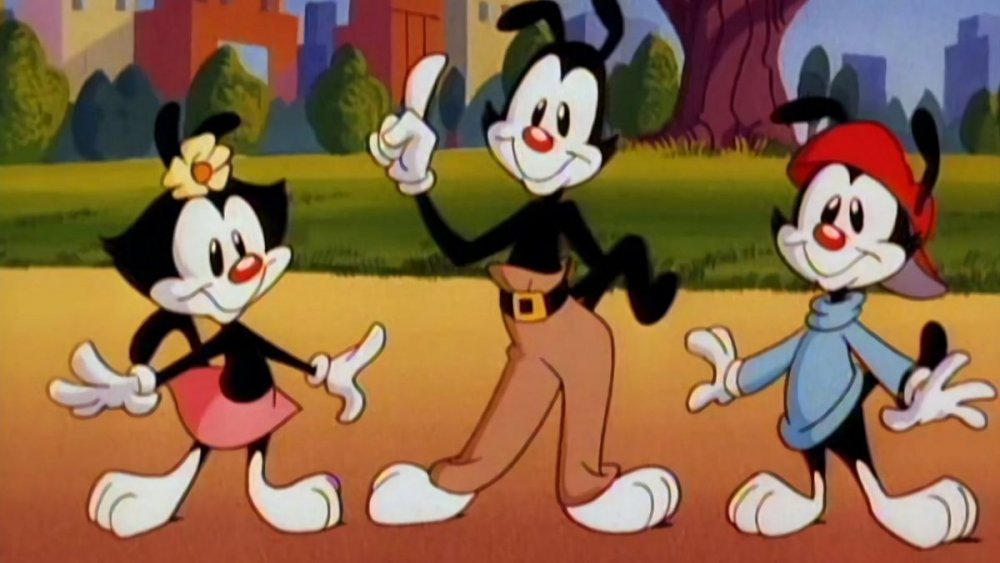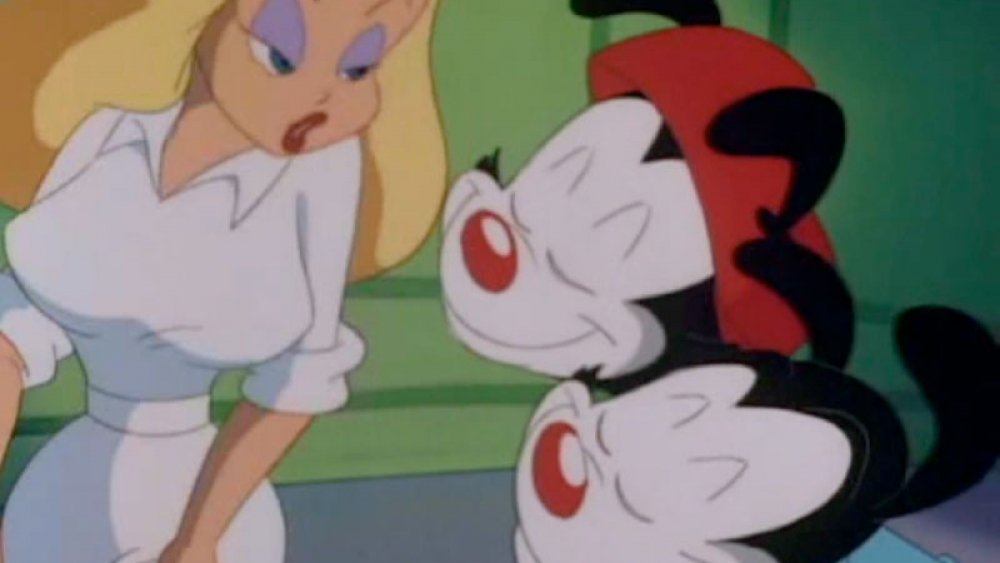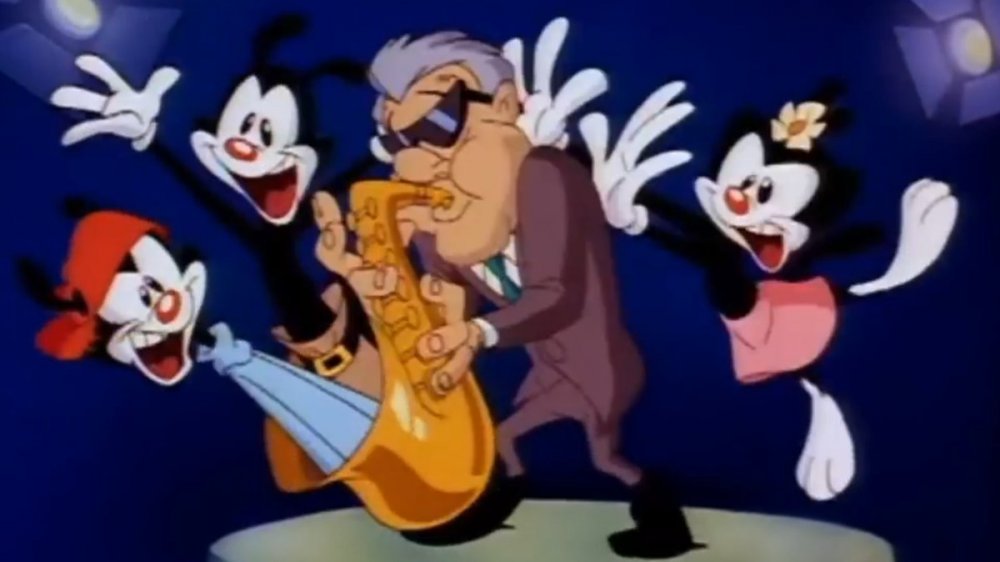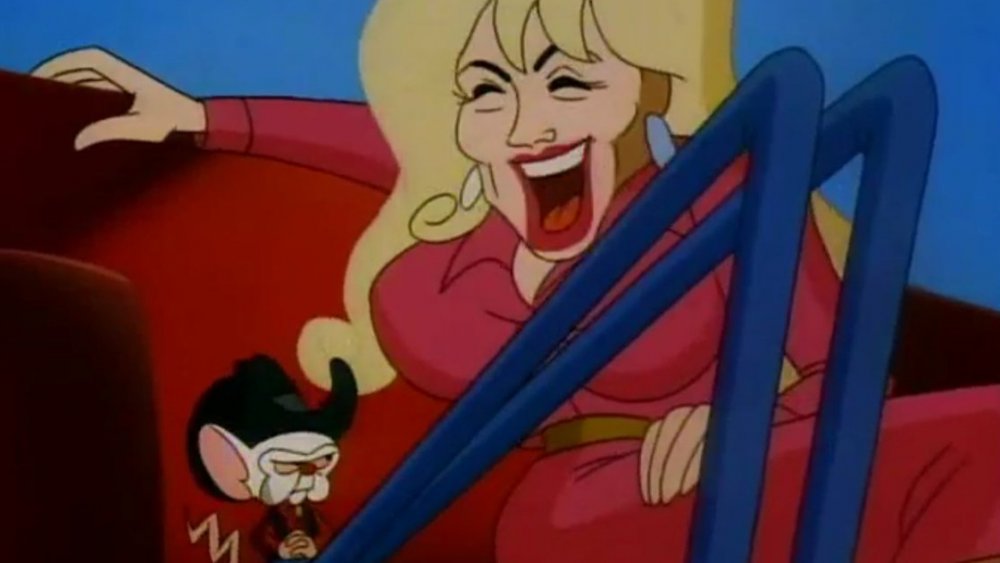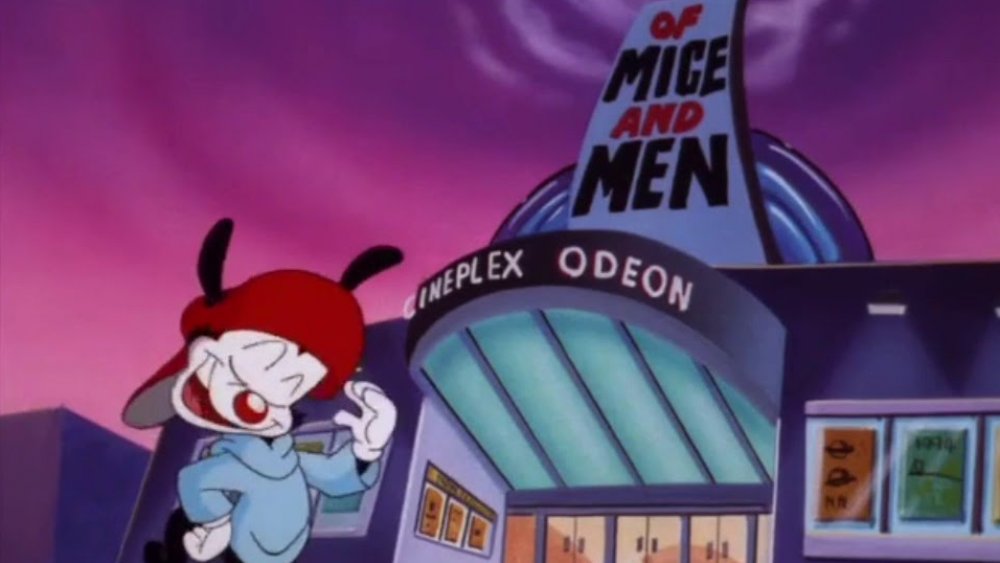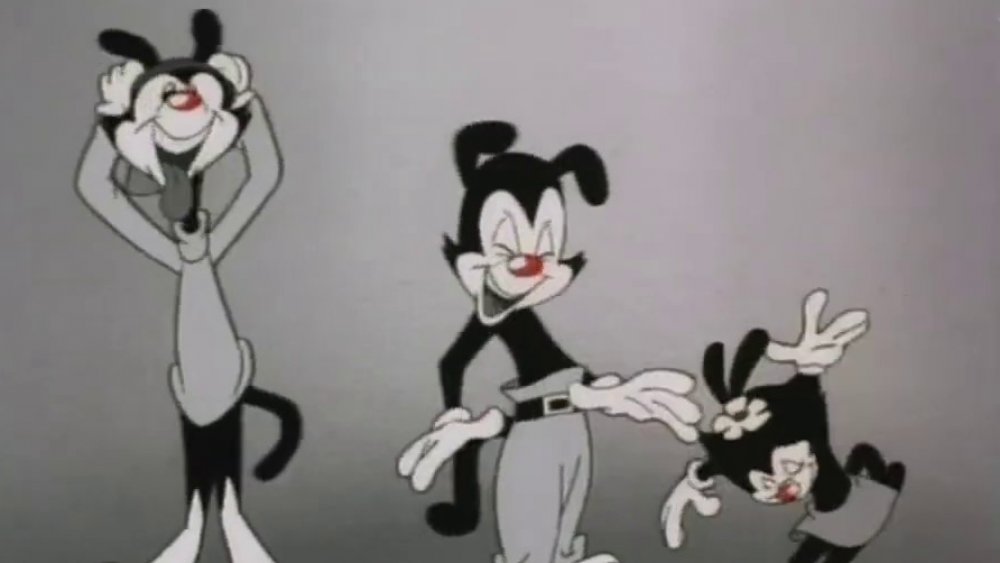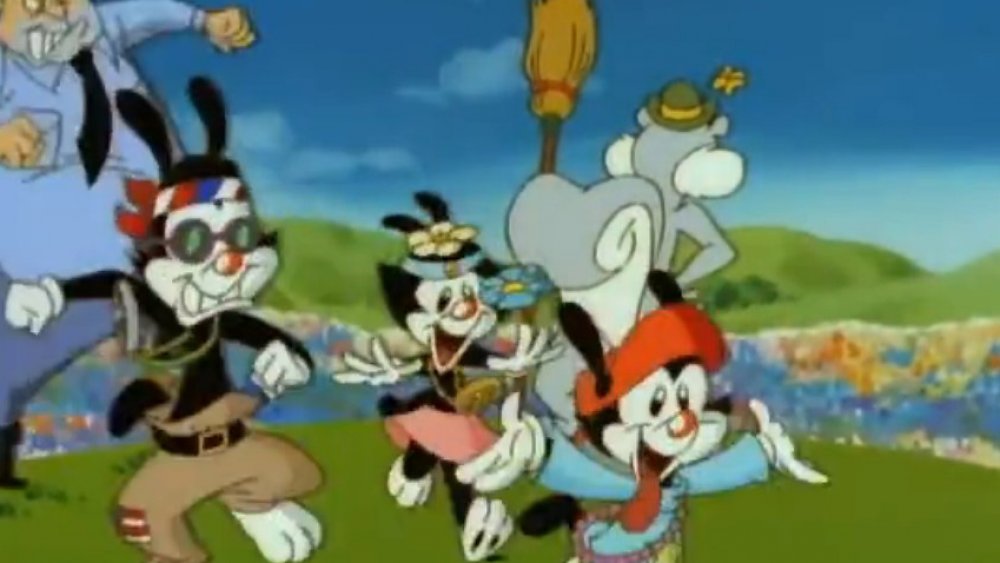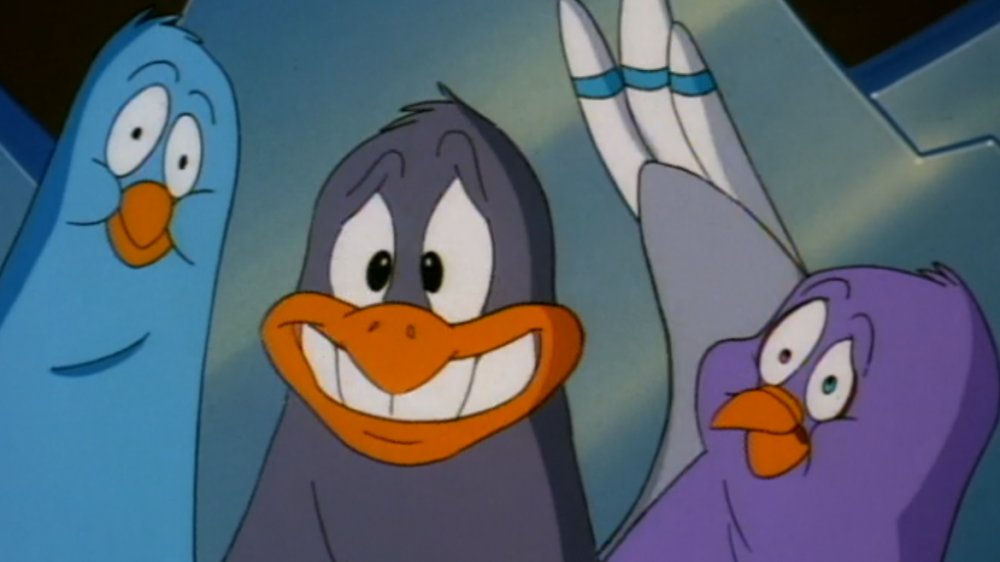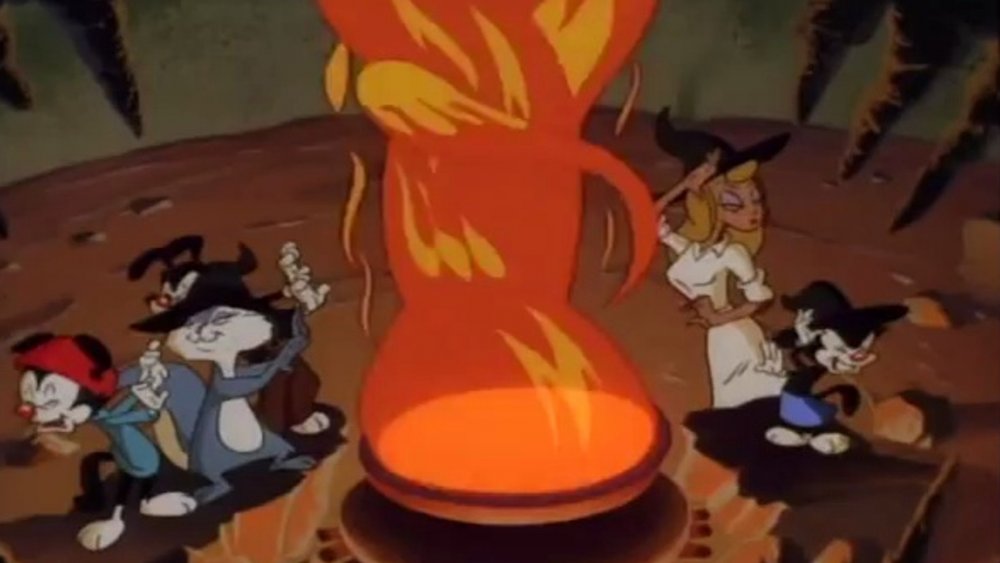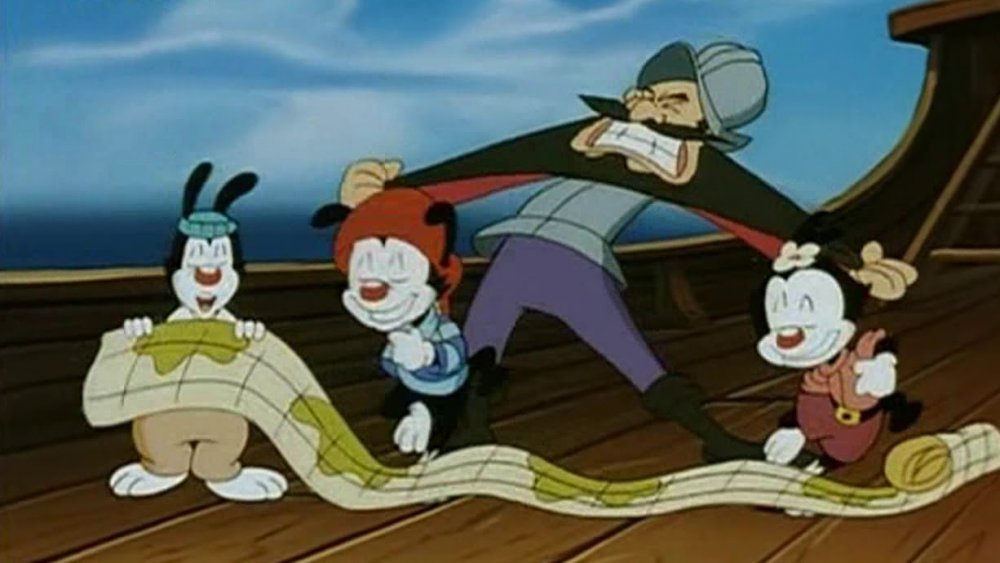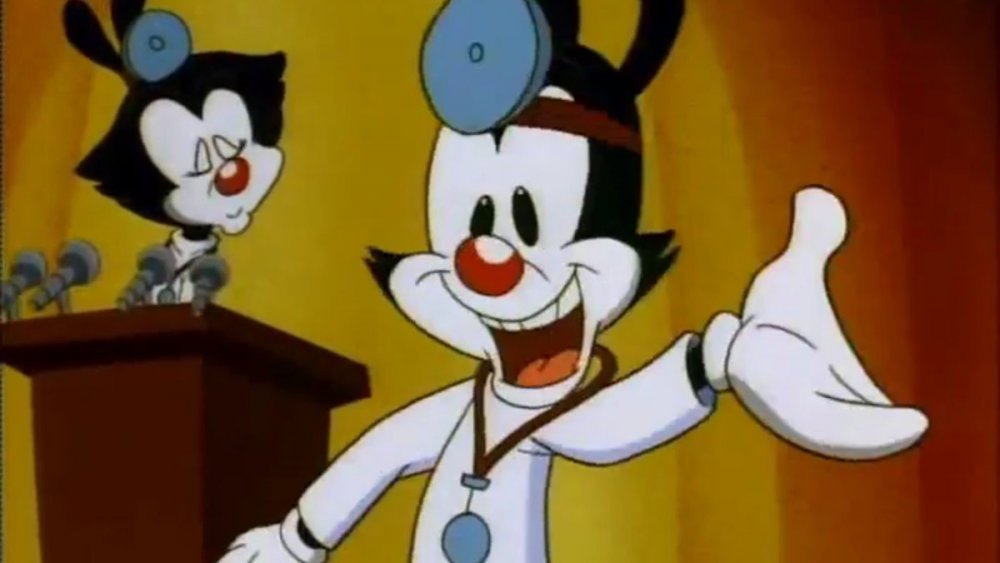Things Only Adults Notice In Animaniacs
At a time when slapsticky anthology cartoon shows were going out of fashion, Animaniacs stepped in as a holdover from a bygone era, as well as a bridge into modern satire. Though made for children, Animaniacs did not shy away from using current affairs, historical knowledge, raunchy humor, and a heaping dose of cinema references more suited to a savvy adult audience. While children of the '90s were chuckling at the mischievous antics of Yakko, Wakko, and Dot, their parents were nodding appreciatively at every wisecrack about the Clinton-Lewinsky scandal or off-color phrase that could be too easily misconstrued as inappropriate. Well, the cool parents were doing that, anyway.
A spiritual successor to the wartime-era Looney Tunes, Animaniacs lives on as a reminder of how a cartoon could be both clever and irreverent, how it could be for children without speaking down to them. It's gratifying to go back as an adult to explore some of those little references and jokes that none of us would have ever picked up on when watching it the first time through.
"Hello, Nurse!"
Perhaps the most recognizable and talked-about aspect of Animaniacs that is solidly meant for adult amusement is the proliferation of sexual innuendo. Yakko and Wakko are constantly howling at an array of busty, Jessica Rabbit-esque female characters with their resounding "Hello, Nurse!" But even though their sister Dot is critical of their overenthusiastic libidos, she commits her fair share of ogling, shmoozing, and even kissing many handsome male counterparts to these "nurse" types. But the sexy shenanigans go beyond mere catcalls and whistles.
In the episode "Hercule Yakko," itself a reference to Agatha Christie's famous detective Hercule Poirot that would likely miss a young audience, Yakko asks Dot to "dust for prints." She dutifully does so, and when she calls for her brother's attention with the singer Prince in her arms, he admonishes her: "No, no, no — fingerprints!" Dot takes a look at Prince and replies, "I don't think so," implying something far more lewd than searching for clues.
And in "Wakko's America," the Warners are playing Jeopardy in class when Wakko chooses the question asking him to name all 50 state capitals. When asked how much of his winnings he will wager on this endeavor, he fearlessly proclaims: "I'll blow the wad!" Yakko and Dot look understandably shellshocked before Wakko launches into his song about the state capitals, answering the question perfectly — but unfortunately not in the form of a question!
Animaniacs' Saturday morning political satire
Younger viewers probably aren't going to get a lot out of the political satire of the show, but there's plenty of it to be had. Even something as innocuous and ostensibly educational as "The Presidents Song" takes opportunities to poke fun at the foibles of the U.S. presidents. The song ends with the encouragement that the viewer might become president one day, and then: "...the press will distort everything you say/so jump in your plane and fly away!"
Historical figures got their fair share of ribbing, but then-president Bill Clinton was a regular target for the Warners. From the opening song where a cartoon Clinton plays his much-recognized saxophone, to references to the Whitewater scandal, to visual gags implying his affair with Monica Lewinsky, Clinton just couldn't escape the satirical beam of Animaniacs. He and Hillary were both regulars on the Pinky and the Brain segments of the show, as well, since Brain's entire goal was world domination, providing him the opportunity to rub elbows with many world leaders. Again, unless kids were preternaturally interested in current politics, it is doubtful that they would fully grasp much of the humor in these segments, though the names would certainly be familiar to them.
Animaniacs' cavalcade of celebrity cameos
Political figures are far from the only cartoon cameos to appear on Animaniacs. While celebrities are probably more recognizable than dead presidents, there are a fair few who traipsed across the small screen without acknowledgement by their pint-sized viewers. One regular was the man himself, the show's executive producer, Steven Spielberg. As a director, writer, and producer, Spielberg's not exactly famous for his face — especially with kids. But since the show took place at the Warner Brothers lot and played with the setting of Hollywood a great deal, it made sense for such a figure to make his way onto the scene every now and then.
In addition to Prince's saucy appearance, other singers like Madonna and Dolly Parton sashayed onto the screen, as well. And in a portion of the episode "Chairman of the Bored," a scene depicting Hollywood luminaries like Morgan Freeman, Cher, and Clint Eastwood seems to take its cue from the Looney Tunes short "Hollywood Steps Out" from way back in 1941. The chances that kids would know the current celebrities are middling at best, but they surely wouldn't have picked up on the reference to old Hollywood, either — though that would probably be a stretch for many adults, as well, unless they grew up in the '40s themselves.
Animaniacs satirized Hollywood from the inside
Something that really sets Animaniacs apart from other cartoons is that it is completely beholden to its Hollywood setting. The Warners were created as studio mascots of a sort, and then locked in the lot's water tower when they became completely uncontrollable. Their entire existence revolves around Hollywood, though it's frequently a Hollywood that is barely recognizable today — one which began when Tinseltown was still subject to the studio system of contracts and churning out films in just a few months. And the Warners were not afraid of mocking Hollywood, the studio executives, and especially critics.
They took two opportunities to sing about the trade papers, referring to Hollywood speak as a language spoken "by those folks who went to school for just a week," and "used by all those folks who can't chew gum and also walk." Paired with the plethora of celebrity appearances and their penchant for referencing older material, Animaniacs is a cinephile's dream — and it's unlikely that any kid watching it, back in the '90s or today, would know enough about the business end of Hollywood to really get these jokes.
Animaniacs targeted movies from decades before its audience was born
The pilot episode of Animaniacs opens with an old-fashioned newsreel depicting the various stars of black and white cinema: Charlie Chaplin in The Gold Rush, Buster Keaton in The General, Clark Gable in Gone With the Wind, and Humphrey Bogart in The Maltese Falcon are immediately recognizable — to someone who is familiar with old film. Bogart in particular comes up repeatedly, especially in his role as Rick in Casablanca. In the Pinky and the Brain short "Star Warners," Bogie shows up behind the bar in the parody of the famous cantina scene from Star Wars. And of course, there's a full-fledged Casablanca reference, taken nearly line for line from the end of the classic film, where Dot takes up Ingrid Bergman's role as Ilsa.
Truly, Casablanca is a beloved film, and Bogart an easily recognizable, easily parodied caricature of an actor — a persona he played as much on-screen as off. But what kid in the early '90s was watching films from the '40s? It's odd that Animaniacs chose to make so many references to old Hollywood, considering their target audience. But they didn't stop with Bogie's greatest hits.
"Who's On First" at Woodstock
Animaniacs was a series that loved clever wordplay, and one of the greatest examples of cinematic genius in wordplay is that timeless Abbott and Costello bit, "Who's On First?" It's an eight-minute burlesque comedy routine of misunderstanding. Slappy Squirrel and her nephew Skippy had their own riff on this, in which Slappy is insistently asking Skippy the name of the band on stage at what appears to be a Woodstock-esque concert. Skippy informs her that it's "Who," as in the band the Who, and the antics ramp up from there, the back and forth banter made more hilarious when Slappy believes the band might be Yes.
The "Who's On First" reference is funny enough on its own, but the added level of musical humor is especially gratifying for anyone with a penchant for classic rock of the '60s and '70s — which children of the '90s would only know about from their Boomer parents or grandparents.
The Goodfeathers brought gangsters to kids' TV
Somehow, despite the fact that the young and impressionable should not be subjected to violent mobster movies like Goodfellas or The Godfather, children learn the stereotypical speech patterns and swagger of Italian movie mafiosos fairly early on. Even though young viewers might not appreciate the ways in which the pigeon trio known as "the Goodfeathers," comprised of Squit, Pesto, and Bobby, parody these classic films, they can appreciate that the birds act and sound funny.
Their parents are likely to gain more from the birds' references to the Scorsese and Coppola classics, especially the mumbling, raspy voice of the Godpigeon, in a spoof of Marlon Brando's whispery tones as Don Corleone. While the violence exhibited by the Goodfeathers never reaches horse-head-in-your-bed heights, they still portray the territorial tendencies of organized crime gangs everywhere, albeit in a constant hunt for food instead of making the rounds to collect "insurance."
Animaniacs wasn't afraid to reimagine literature
Classic cinema is not Animaniacs' only dubiously appropriate reference material. Paired with their forays into history and geography education, it seems that the show's writers were interested in instilling a love of literature in their audience. It is unlikely that any pre-high school fan would be familiar with the works of Shakespeare outside of Romeo & Juliet, but the show opted to parody the famous tragedy Macbeth anyway. In this rendition, the three famous witches are played by Slappy Squirrel, Dot Warner, and the eponymous Hello Nurse, with their Shakespearean dialogue "translated" by Yakko. Whether this translation helps kids to really understand the true essence of Macbeth is doubtful, but it does make for some silly gags. Adults are obviously more well-equipped to understand the source material and appreciate the off-color interpretation.
In a slightly more heartfelt tribute, "Mighty Wakko at the Bat" takes the Ernest Lawrence Thayer poem "Casey at the Bat" and reforms it to narrate the tribulations of the Warner baseball team. For kids, this is a fun rhyming short with no basis on anything else. For poetry-loving grown-ups, it's a nice little gem that's easily overlooked.
The historical accuracy (and historical license) of Animaniacs
We've already seen how Animaniacs uses history to tell jokes, and even provide a little bit of insight for viewers who might be covering topics like the U.S. presidency in their elementary school classes. But not every fact espoused in these cartoons should be taken at face value, and hopefully not too many kids were led astray in their classwork because they believed something that was a joke. "The Ballad of Magellan," for instance, is guilty of over-simplifying the man's journey. It wouldn't be catchy to include every minute detail of Magellan's life in a comedy short, so at least Animaniacs were doing what no other cartoon was by introducing the figure to their audience, albeit without context.
The show even broached on art history, notably poking fun at Picasso, an artist whose name children would more likely recognize. When Picasso tells the Warners that he painted a group of works "in my blue period" or "in my rose period," he is referencing very specific groups of paintings — which were not depicted even in parody in the cartoon. Rather, the show exhibits clown paintings and landscapes of the kind that the master of Cubism would never have attempted.
"Good night, everybody!"
There are countless other gags, references, and parodies that could be drummed up in an effort to show just how off-color and out-there Animaniacs was, allowing us to marvel at how it ever got made and how it succeeded in remaining a fond memory for so many Millennials who likely only got part of the joke. Thankfully, Yakko gave us a convenient phrase to use when something untoward crops up in the show — sort of an all-ages "that's what she said." In several moments over the course of the show, when a character said a technically innocent line that could be easily misconstrued as something naughty, Yakko would blow a huge kiss and exclaim: "Good night, everybody!"
Everything from "Stop playing with my bust!" to "I'll conjugate with you" was subject to his wandering mind, and his need to draw attention to these phrases might not have been well understood by his audience, but surely they were subtly learning how to pick out unintentional innuendo. And truly, all of Animaniacs can be marked by that spirit of irreverent mischief, educating its audience through obscure historical and cinematic references, treating them like small, clever adults instead of children who needed their hands held through a viewing. And perhaps that level of satirical sophistication is what has kept it alive in the hearts of viewers of all ages for all these years.
